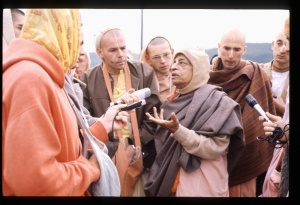CC Madhya 17.149

A.C. Bhaktivedanta Swami Prabhupada
TEXT 149
- ‘prayāge’ āsiyā prabhu kaila veṇī-snāna
- ‘mādhava’ dekhiyā preme kaila nṛtya-gāna
SYNONYMS
prayāge—to Prayāga; āsiyā—coming; prabhu—Śrī Caitanya Mahāprabhu; kaila—did; veṇī-snāna—bathing in the confluence of the Ganges and Yamunā; mādhava—the predominating Deity there, Veṇī Mādhava; dekhiyā—seeing; preme—in ecstatic love; kaila—performed; nṛtya-gāna—dancing and chanting.
TRANSLATION
Śrī Caitanya Mahāprabhu then went to Prayāga, where He bathed at the confluence of the Ganges and the Yamunā. He then visited the temple of Veṇī Mādhava and chanted and danced there in ecstatic love.
PURPORT
The city of Prayāga is situated a few miles from the city of Allahabad. The name Prayāga is given due to successful sacrifices performed there. It is said, prakṛṣṭo yāgo yāga-phalaṁ yasmāt. If one performs sacrifices at Prayāga, he certainly gets immediate results without difficulty. Prayāga is also called Tīrtharāja, the king of all places of pilgrimage. This holy place is situated on the confluence of the rivers Ganges and Yamunā. Every year a fair takes place there known as Māgha-melā, and every twelve years a Kumbha-melā is also held. In any case, many people come to bathe there every year. During Māgha-melā, people from the local district generally come, and during Kumbha-melā people come from all over India to live there and bathe in the Ganges and Yamunā. Whoever goes there immediately feels the place’s spiritual influence. A fort located there was constructed by the emperor Akbar about five hundred years ago, and near the fort is a place called Triveṇī. On the other side of Prayāga is an old place known as Pratiṣṭhāna-pura. It is also well known as Jhuṅsi. Many saintly people live there, and consequently it is very attractive from the spiritual point of view.